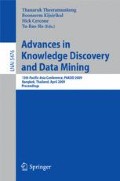Abstract
We propose a new approach to modeling time-varying relational data such as e-mail transactions based on a dynamic extension of matrix factorization. To estimate effectively the true relationships behind a sequence of noise-corrupted relational matrices, their dynamic evolutions are modeled in a space of low-rank matrices. The observed matrices are assumed as to be sampled from an exponential family distribution that has the low-rank matrix as natural parameters. We apply the sequential Bayesian framework to track the variations of true parameters. In the experiments using both artificial and real-world datasets, we demonstrate our method can appropriately estimate time-varying true relations based on noisy observations, more effectively than existing methods.
Access this chapter
Tax calculation will be finalised at checkout
Purchases are for personal use only
Preview
Unable to display preview. Download preview PDF.
References
Getoor, L., Diehl, C.P.: Link mining: a survey. SIGKDD Explor. Newsl. 7(2), 3–12 (2005)
Gordon, G.J.: Generalized 2 linear 2 models. In: Advances in Neural Information Processing Systems, vol. 15 (2003)
Yu, K., Chu, W., Yu, S., Tresp, V., Xu, Z.: Stochastic relational models for discriminative link prediction. In: Schölkopf, B., Platt, J., Hoffman, T. (eds.) Advances in Neural Information Processing Systems 19, pp. 1553–1560. MIT Press, Cambridge (2007)
Srebro, N., Rennie, J.D.M., Jaakkola, T.S.: Maximum-margin matrix factorization. Advances in Neural Information Processing Systems 17 (2005)
Salakhutdinov, R., Mnih, A.: Probabilistic matrix factorization. In: Platt, J.C., Koller, D., Singer, Y., Roweis, S. (eds.) Advances in Neural Information Processing Systems 20. MIT Press, Cambridge (2008)
Sun, J., Tao, D., Papadimitriou, S., Yu, P.S., Faloutsos, C.: Incremental tensor analysis: theory and applications. ACM Transactions on Knowledge Discovery from Data (2008)
Tao, D., Song, M., Li, X., Shen, J., Sun, J., Wu, X., Faloutsos, C., Maybank, S.J.: Bayesian Tensor Approach for 3-D Face Modeling. IEEE Transactions on Circuits and Systems for Video Technology 18(10), 1397–1410 (2008)
Carley, K.M.: Dynamic network analysis. In: Breiger, R., Carley, K.M., Pattison, P. (eds.) Dynamic Social Network Modeling and Analysis: Workshop Summary and Papers, Washington, DC, pp. 133–145 (2003)
Mccullagh, P., Nelder, J.: Generalized Linear Models, Second Edition. Chapman & Hall/CRC (August 1989)
Hoff, P.D.: Model averaging and dimension selection for the singular value decomposition. Journal of the American Statistical Association 102(478), 674–685 (2007)
Shetty, J., Adibi, J.: The Enron email dataset database schema and brief statistical report. Information Sciences Institute Technical Report, University of Southern California (2004)
Bradley, A.P.: The use of the area under the roc curve in the evaluation of machine learning algorithms. Pattern Recognition 30(7), 1145–1159 (1997)
Sarkar, P., Moore, A.W.: Dynamic social network analysis using latent space models. SIGKDD Explor. Newsl. 7(2), 31–40 (2005)
Blei, D.M., Lafferty, J.D.: Dynamic topic models. In: ICML 2006: Proceedings of the 23rd international conference on Machine learning, pp. 113–120. ACM Press, New York (2006)
Blei, D.M., Ng, A.Y., Jordan, M.I.: Latent dirichlet allocation. Journal of Machine Learning Research 3, 993–1022 (2003)
Buntine, W.L.: Variational extensions to em and multinomial pca. In: Elomaa, T., Mannila, H., Toivonen, H. (eds.) ECML 2002. LNCS, vol. 2430, pp. 23–34. Springer, Heidelberg (2002)
Doucet, A., Defreitas, N., Gordon, N.: Sequential Monte Carlo Methods in Practice. Springer, Heidelberg (2001)
Author information
Authors and Affiliations
Editor information
Editors and Affiliations
Rights and permissions
Copyright information
© 2009 Springer-Verlag Berlin Heidelberg
About this paper
Cite this paper
Hayashi, K., Hirayama, Ji., Ishii, S. (2009). Dynamic Exponential Family Matrix Factorization. In: Theeramunkong, T., Kijsirikul, B., Cercone, N., Ho, TB. (eds) Advances in Knowledge Discovery and Data Mining. PAKDD 2009. Lecture Notes in Computer Science(), vol 5476. Springer, Berlin, Heidelberg. https://doi.org/10.1007/978-3-642-01307-2_41
Download citation
DOI: https://doi.org/10.1007/978-3-642-01307-2_41
Publisher Name: Springer, Berlin, Heidelberg
Print ISBN: 978-3-642-01306-5
Online ISBN: 978-3-642-01307-2
eBook Packages: Computer ScienceComputer Science (R0)

